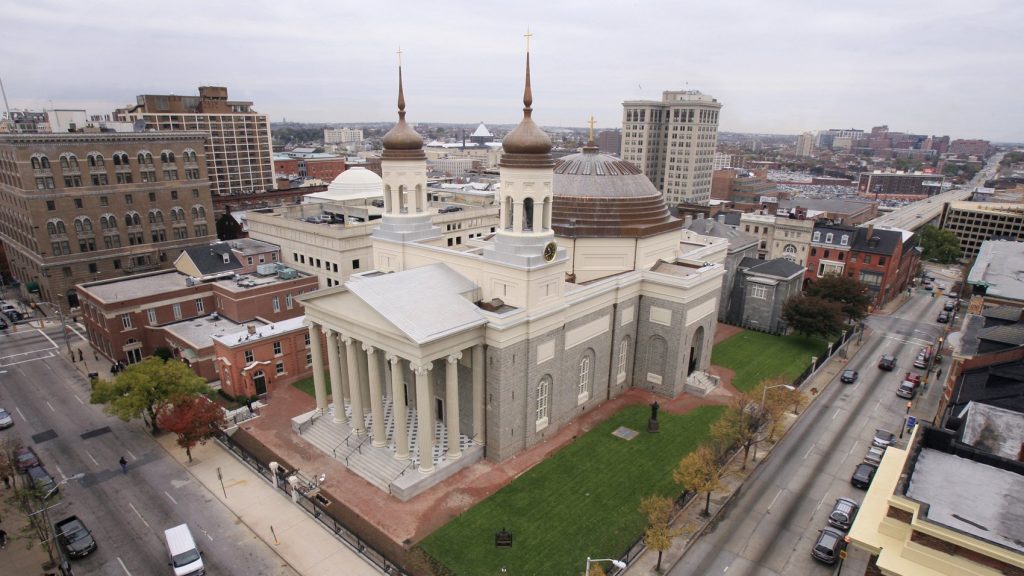Baltimore’s archbishop called on Catholics to “make history,” at the bicentennial Mass of America’s first cathedral on Monday, the feast of the Visitation.
At a Mass for the bicentennial of the National Shrine of the Basilica of the Assumption of the Blessed Virgin Mary, Archbishop William Lori of Baltimore emphasized that the basilica’s rich history must not distract Catholics from continuing the Church’s evangelization right now.
The historic basilica exists “not only to celebrate history, but to make history,” Archbishop Lori said, further explaining the basilica’s Marian mission on the feast of the Visitation, on which the basilica was also consecrated 200 years prior.
“This cathedral finds in its patroness the Blessed Virgin Mary, an even more sublime model and patron for its form, its prayer, and its mission,” he said on Monday, “If, as St. Paul says, we are all temples of the Lord, even more can be said of Mary,” the “temple in whom God dwelt.”
“From this basilica, there arises Mary’s timeless hymn of praise,” he said, the “Magnificat,” which Mary proclaimed upon visiting her cousin Elizabeth in the Gospel of Luke.
“Like Mary, having received our Lord in our hearts, we too become temples,” he said, “called to bring Christ outward, outward no longer to the hill country of Judea, but now to the streets of Baltimore and beyond, streets where we meet Jesus in His most distressing disguises” as the homeless and the poor.
The National Shrine of the Basilica of the Assumption of the Blessed Virgin Mary in Baltimore – the first cathedral built in the United States – celebrated its bicentennial on Monday. Archbishop Lori celebrated Monday’s bicentennial Mass, with basilica rector Fr. James Boric concelebrating.
Consecrated on May 31, 1821, the basilica cornerstone was laid in 1806 by Bishop John Carroll, the first Catholic bishop in the United States.
Archbishop Lori noted in his homily on Monday that the Archdiocese of Baltimore initially stretched from Canada to Florida, and west to the Mississippi River, during the early days of the United States.
“It was a vast new diocese in a vast new country,” he said, adding that Bishop Carroll knew Catholics “would need a spiritual center, a new cathedral.” The bishop asked Catholics to give annually for the construction of the basilica, and “like a good American, he also instituted a lottery” to help pay for a church “that would be a beautiful manifestation of the Catholic faith in the spirit of the new republic.”
Architect Benjamin Henry Latrobe oversaw the building’s design and architecture; Latrobe also helped design the U.S. Capitol. The basilica was built in the neoclassical style instead of the popular Gothic Revival church architecture of the time, reflecting the new nation’s capital of Washington, D.C.
The neoclassical architecture letting in natural light pointed to the light of faith, the light of reason, and the “sunlight of authentic freedom,” Lori said.
Archbishop Ambrose Marichal, the third archbishop of Baltimore, saw the cathedral finished and consecrated it on May 31, 1821.
“It was in view of this edifice’s sublime and holy ends that the archbishop dedicated it to God,” Lori said.
The archbishop prayed for Catholics to receive at the basilica “courage in their temptations, comfort in their afflictions and infirmities, light in their doubts, and all the graces necessary to persevere in the love and the service of God,” Lori said, quoting Marichal’s pastoral letter from the time of the consecration.
The basilica hosted several provincial and plenary councils of U.S. bishops where the Catholic school system was devised and the Baltimore Catechism were commissioned. Pope Pius XI declared the cathedral a minor basilica in 1937, and in 1972 it was declared a National Landmark.
Archbishop Lori mentioned the beginning of perpetual Eucharistic adoration at the basilica, the first church in the city of Baltimore to host perpetual adoration. Missionaries who live at the basilica under the “Source of All Hope” initiative will draw special graces from adoration, he said, in their ministry to the local poor and homeless.
These missionaries, he said, are treating the poor “not as a problem to be solved, but as human beings endowed by God with inalienable rights and called to friendship with Him.”
“At the heart of this friendship is the Eucharist, and Eucharistic adoration,” he said. Archbishop Lori blessed the adoration chapel on Monday after Mass.
The archbishop also welcomed priests, deacons, religious, seminarians, parish members, and people of the archdiocese who were present at the Mass, as well as Knights of Columbus – noting that Fr. Michael McGivney, founder of the Knights of Columbus was ordained at the basilica.
He called on Catholics present to imitate Mary, the patroness of the basilica.
“Dear friends, on this solemn and joyous occasion, may we, faithful to the promptings of the Holy Spirit, magnify the greatness of the Lord together with Mary and all the saints, and through Mary’s intercession, may the song of praise resound within these walls, and echo far beyond them for hundreds and thousands of years to come,” he said.
Monday’s Mass kicks off a year of planned events at the basilica. A celebration of the basilica’s patronal feast day of the Assumption will take place in August. Cardinal Timothy Dolan of New York will deliver a lecture on the history of the basilica and the archdiocese on August 14. The next day, Bishop Robert Barron, auxiliary bishop of Los Angeles, will deliver the homily at a Mass celebrated by Archbishop Lori at the basilica.
In November, the U.S. bishops will concelebrate Mass together at the basilica, as they normally do at their annual fall meetings in Baltimore. The basilica also plans to host Cardinal Robert Sarah, the former prefect of the Vatican’s Congregation for Divine Worship, in May 2022.

